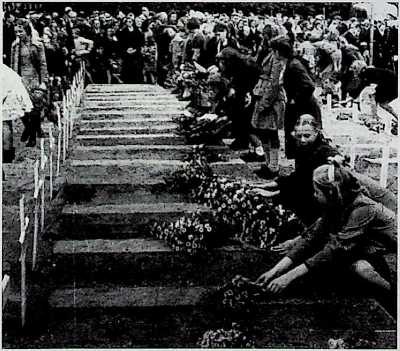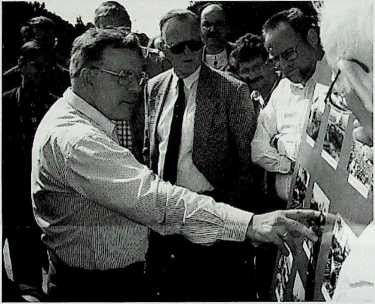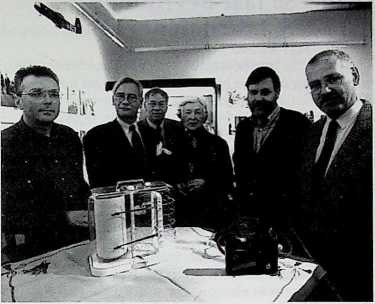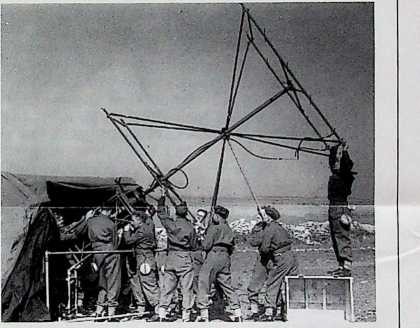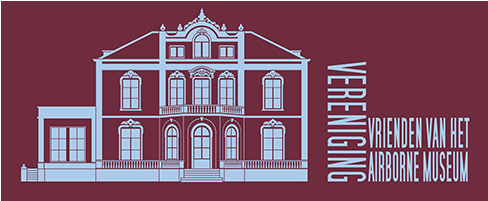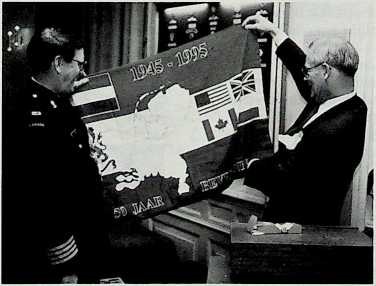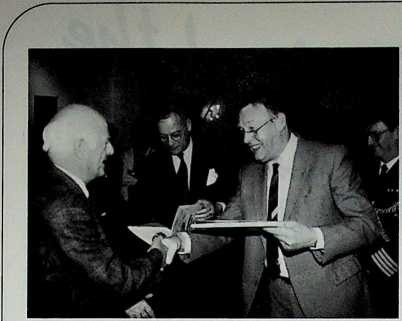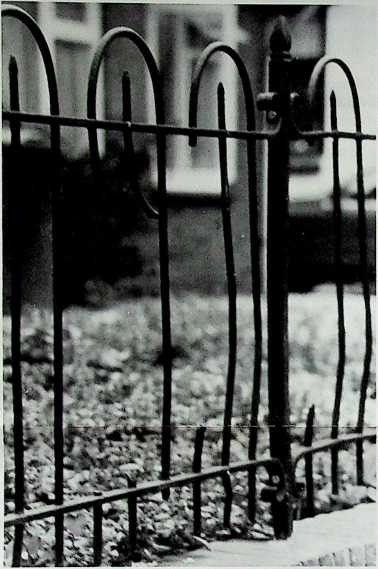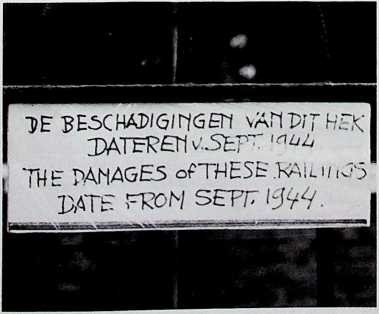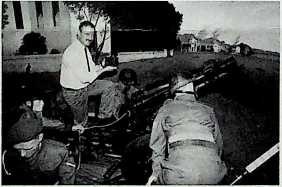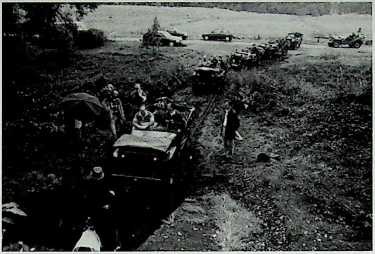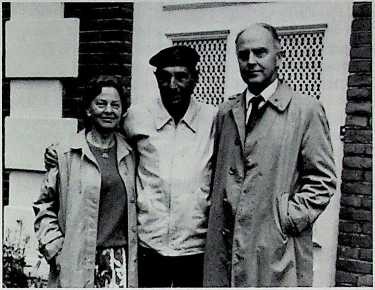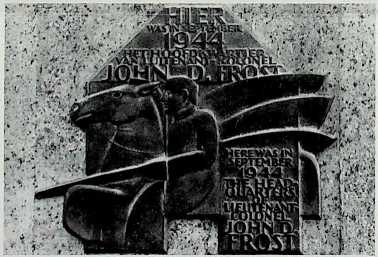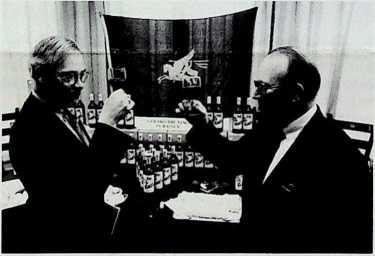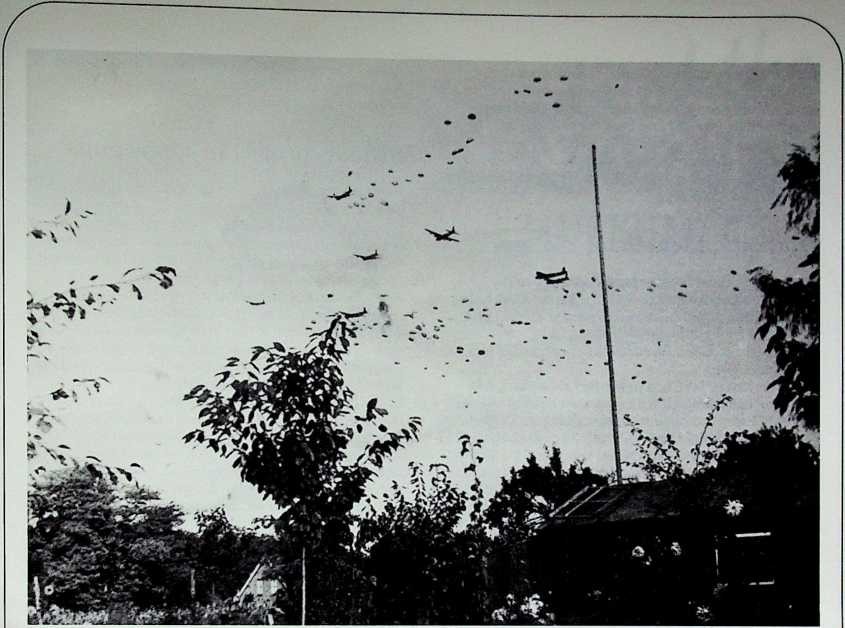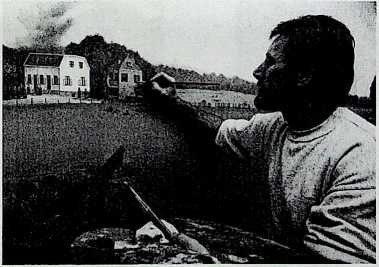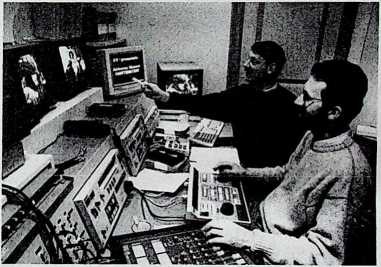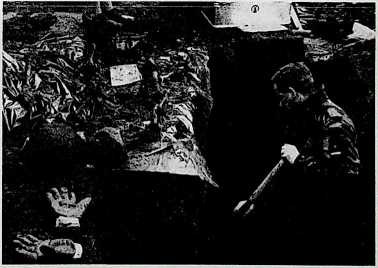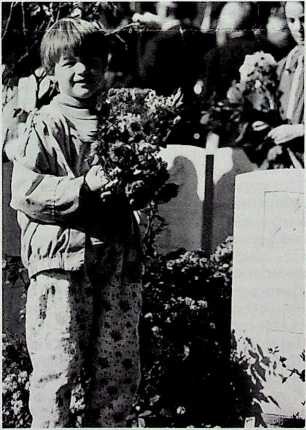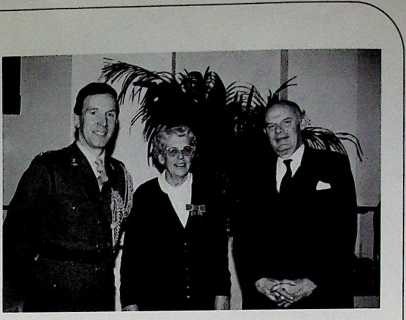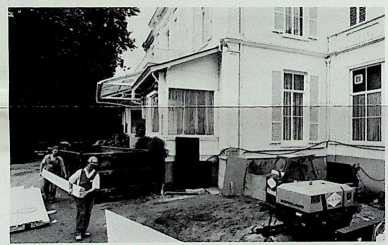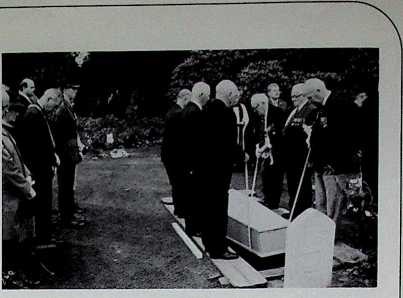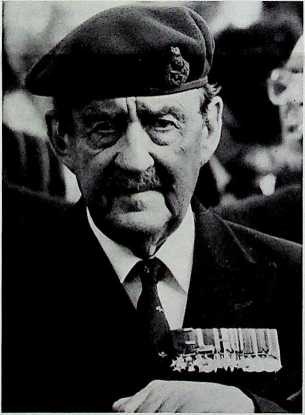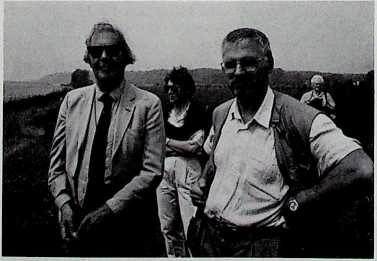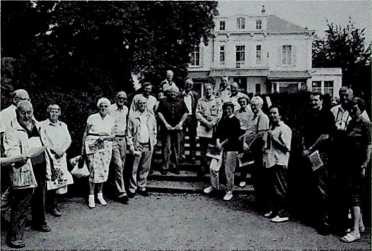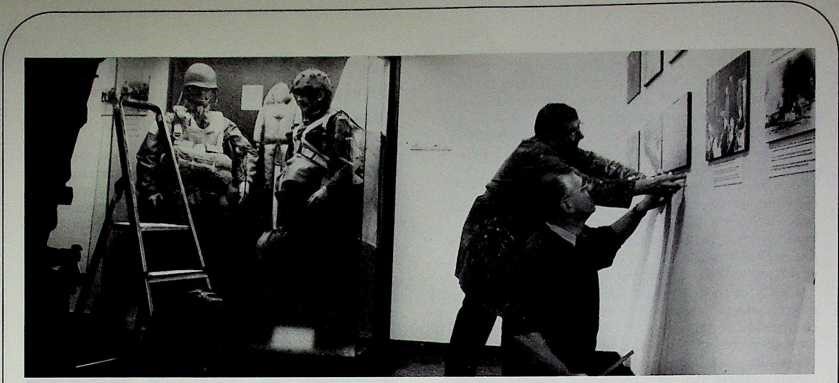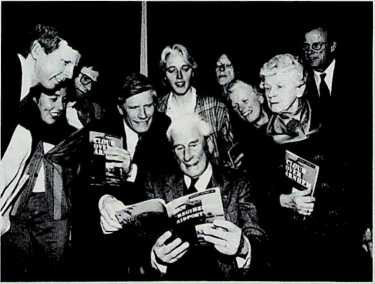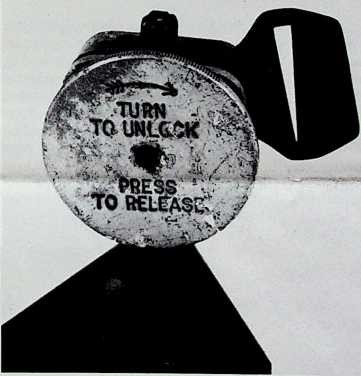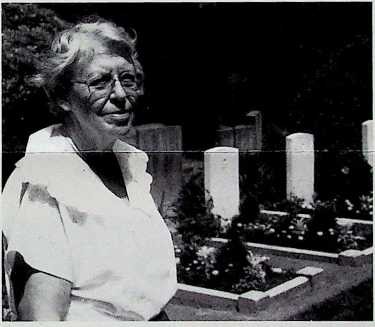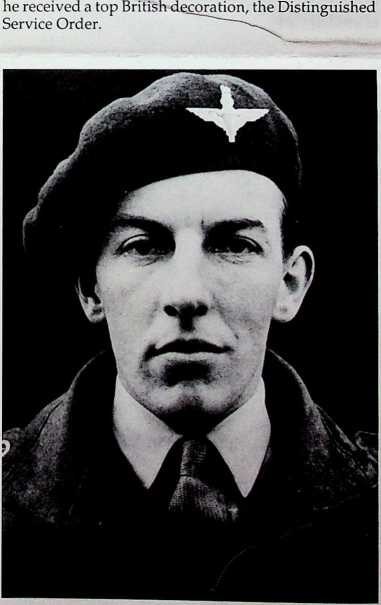Utrechtseweg 232 6862 AZ Oosterbeek The Netherlands
NEWSLETTER No. 54, May 1994
Translated by Cathrien and Peter Clark
Representative in Great Britain: Mr. E.E. Shaw, 298 Totnes Road Paignton – Devon TQ4 7HD Tel. 0803-553616
From the editors
The 50th commemoration of the Battle of Arnhem is already some way behind us. The days between 14 and 18 September were characterised by a kaleidoscope of happenings. The programme folder listed dozens of events, both big and small.
The official commemoration began on Thursday 15 September with a meeting in the Rijnhal in Arnhem during which the veterans were presented with a special commemorative medal. At the same time a service was held at the Eusebius Church with Prince Willem Alexander as guest of honour. On Friday 16 September some 5,000 British, Poles and local inhabitants sat down together for a veterans/civilians lunch which was laid on for them by 60 catering establishments in Arnhem. The traditional Silent Procession to the Airborne Monument at the Rhine bridge took place later that afternoon.
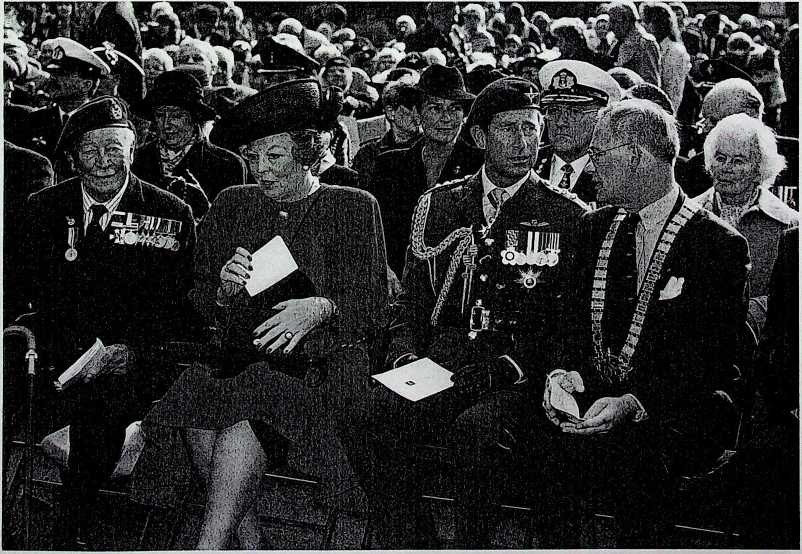
Airborne Cemetery, Sunday 19 September 1994. From left to right; General Sir John Hackett, Queen Beatrix, Prince Charles, drs. J. W.A.M Verlinden, burgomaster ofRenkum municipality.
(photo: Berry de Reus)
Despite the bad weather on Saturday 17 September, 700 mainly British parachutists made a parachute descent onto Ginkel Heath watched by tens of thousands of spectators, including Prince Bernhard and Prince Charles. Unfortunately, the memorial jump by 70 veterans had to be postponed to the following day, when it went ahead at Teuge airfield. A huge parade along Onderlangs in Arnhem took place on Saturday afternoon. This attracted many onlookers.
The high point was undoubtedly the emotional service of remembrance at the Airborne Cemetery at which Queen Beatrix and Prince Charles were the guests of honour.
This exceptional commemoration not only attracted enormous interest from veterans and civilians but also from the world press. ‘Arnhem’ made the front pages of many newspapers and it received extensive coverage on television.
In this Newsletter we have made a selection from the news surrounding the 50th commemoration and we shall be returning to the subject in the next issue.
‘Theme afternoon’, Saturday 17 December next
The annual Theme afternoon organised by our association will be held on Saturday 17 December next in the Concert Hall, Rozensteeg 3, Oosterbeek (tel. 085-332046).
The programme is as follows:
13.30- 14.00: Reception of the members;
14.00-15.00: Lecture by Marcel Anker from Duiven about ‘The fate of C Company, 2nd Parachute Battalion during the Battle of Arnhem’;
15.00-15.30: Intermission;
15.30- 16.45: Showing of the video documentary ‘We’ll See You In September’ (see elsewhere in this Newsletter);
Approx. 17.00: End of the Theme afternoon.
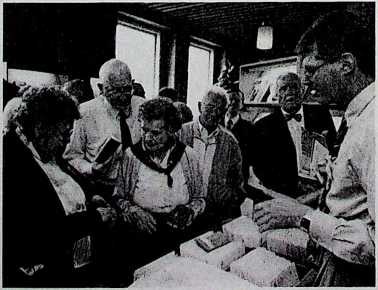
A busy throng at Oosterbeek town hall during the signing-in of the veterans (September 1994). (photo: Berry de Reus)
Message from your UK representative
Thank you for your support of the Friends and for your generosity.
A kindly reminder that subscriptions are due on the 1st of January 1995. Donations are always welcome. Signed: Ted Shaw, UK representative.
Information morning on 17 December
For a number of years now many of our members have been engaged in historical research into various aspects of the Battle of Arnhem. A number of these have now taken the initiative for organising an information morning on Saturday morning the 17th of December. This will be held in the Concert Hall in Oosterbeek.
The members in question will be there, with part of their collections, to explain about their research and to exchange ideas with other members; Okko Luursema will also be on hand with his bookstall. Subjects under the spotlight will include the Glider Pilot Regiment, the 7th Battalion The King’s Own Scottish Borderers, the Reconnaissance Squadron, the battle around Wolfheze, the 2nd Battalion The South Staffordshire Regiment, the Dorsetshire Regiment, C Company of the 2nd Parachute Battalion etc. The Concert Hall will be open from 10 am for all those interested. Admission is free.
21st Independent Parachute Company again ‘first in’
In September 1944,180 men of the 21st Independent Parachute Company jumped onto landing zones ‘S’ and ‘Z’ and dropping zone ‘X’ half an hour before the main force in order to indicate the zones with marker panels, smoke canisters and Eureka beacons. Now, fifty years later, they were again ‘first in’. They arrived in Oosterbeek in a group on 1 September last. During their stay they visited the Airborne Cemetery, laid a wreath at ’their’ monument at the comer of Utrechtseweg and Stationsweg, took part in a battlefield tour and visited the individual places where they had fought during the Battle of Arnhem. David Eastwood, one of the former platoon commanders, was interviewed on one of the landing zones for the new video documentary ‘We’ll See You In September’. With the aid of an original marker panel from 1944 he demonstrated how the dropping and landing zones were indicated for the main force.
Tunnel under the railway embankment excavated in historical reconstruction
A few hundred metres east of Wolfheze station is a small tunnel under the railway embankment. The people of Oosterbeek refer to it as ‘de derde duiker’ (the third culvert), since it is one of three intended for the drainage of excessive rainwater. Cyclists and walkers also make extensive use of it for getting from one side of the Arnhem-Utrecht railway to the other. Few people know that this culvert played an important role during the Battle of Arnhem.
When, on 19 September 1944, the attack by the 10th and 156th Parachute Battalions foundered on the strong German defensive line along the Dreijenseweg, Major-General Urquhart ordered these troops to withdraw from Johannahoeve to the area south of the railway line. According to the War Diary of the 4th Parachute Squadron Royal Engineers and to various other personal accounts, some troops in jeeps made use of this culvert under the railway embankment.
However, doubts arose as to whether this could have actually been possible because the tunnel appeared to be far too narrow and low for jeeps to pass through. Besides this, over the years earth had piled up at both entrances, making access appear even more tight. The only real way to prove if the jeeps could indeed have driven through was to restore the tunnel to its original state.
On Saturday 27 August 1994 a number of volunteers assembled at the culvert, bent on clearing the entrances. With the aid of a digger and driver, provided by the Bouwman company of Arnhem, and the muscle power of members from our association and the Keep Them Rolling group, the entrances at both sides of the embankment were opened up. After two hours labour, accompanied now and then by a miserable, drizzly rain, the work was finished and the engines of the six original jeeps that were on hand were started. The first vehicle drove gingerly into the tunnel, followed closely by the others. The culvert did indeed appear to be big enough. With the windscreen laid flat the jeeps could get through. The initiators of the test were satisfied. It had been proved empirically that the reports from 1944 were correct.Thanks are due to Netherlands Railways for their generous cooperation in this investigation.
Monument to the people of Gelderland
On 14 September 1994, in pouring rain, General Sir John Hackett unveiled a monument alongside the eastern driveway of the Airborne Museum ‘Hartenstein’. With this monument the British wish to express their everlasting gratitude to the people of Gelderland for all the help they gave to the 1st British Airborne Division and the 1st Polish Independent Parachute Brigade Group in September 1944. The inscription reads:
‘To the people of Gelderland.
50 years ago British & Polish Airborne soldiers fought here against overwhelming odds to open the way into Germany and bring the war to an end. Instead we brought death and destruction, for which you never blamed us.
This stone marks our admiration for your courage, remembering especially the women who tended our wounded. In the long winter that followed your families risked death by hiding Allied soldiers and airmen, while members of the Resistance helped many to safety.
You took us into your homes as fugitives and friends, we took you forever into our hearts. This strong bond will continue long after we are all gone.’ The Queen’s Commissioner for Gelderland, Mr. J. Terlouw, thanked General Hackett for this emotive monument. ‘
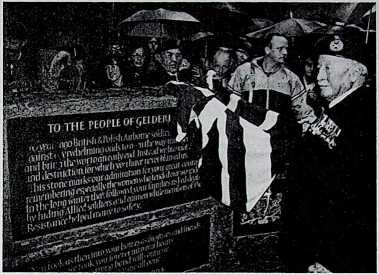
Unveiling of the monument to the people of Gelderland by Sir John Hackett on 14 September 1994.
(photo: Berry de Reus)
Restored Airborne Monument in Heelsum unveiled
In the previous Newsletter we mentioned that an action had been started to collect funds for the restoration of the Airborne Monument in Heelsum. On Wednesday 14 September 1994, almost 49 years after the original unveiling, the completely restored monument was once again unveiled. Major AJ. Hibbert, Brigade Major of the 1st Parachute Brigade in 1944, made a speech after which Mrs. Van de Poll, widow of the Heelsum blacksmith who put the monument together in 1945, carried out the unveiling ceremony assisted by a number of children. The 6 pounder gun, the centre piece of the monument, is once more as new; even the wheels are back on. The area around the monument has also been given a complete tidy-up.
The fine end result can be attributed to excellent cooperation between private individuals, the business community and the local government.
Plaque and bench seat for the Dorsets
In the morning of Friday 16 September 1994 a group of soldiers from the 4th Battalion The Devon and Dorset Regiment crossed the Rhine near the Westerbouwing in four small boats. The group included a number of veterans from the original 4th Battalion The Dorsetshire Regiment.
It was men from this battalion who, under covering fire from the 5th Battalion of the same regiment, crossed the Rhine during the night of 24-25 September 1944 to provide reinforcement to the beleaguered Airborne Division at Oosterbeek. The crossing that night was carried out under murderous German fire, resulting in many dead and wounded. After the 1994 crossing a small parade took place in the grounds of the Westerbouwing restaurant. There then followed a short service during which Lieutenant-Colonel A. Thorburn presented a wooden bench seat to the Renkum municipality. The bench has been given a place on the western side of the restaurant where it looks out over the crossing point of 50 years ago. A plaque was then unveiled on the south wall of the Westerbouwing in memory of the 4th and 5th Battalions The Dorsetshire Regiment.
New monument at Airborne Square in Arnhem
A new monument in the wall around the sunken part of the Airborne Square (‘de Berekuil’ = the Bear pit) was unveiled on 16 September last on the occasion of the 50th commemoration. It consists of two long stone blocks bearing, as text, the motto of the fiftieth anniversary, ‘Battle of Arnhem, Bridge to the Future’. The monument was made by the Oosterbeek artist Marius van Beek.
Monument to the Air Despatchers
One of the areas where large quantities of supplies were dropped to the British Airborne troops in September 1944 was the area to the north of the Airborne Cemetery. On Sunday afternoon 18 September 1994, a monument was unveiled on the southern edge of this area in memory of the Air
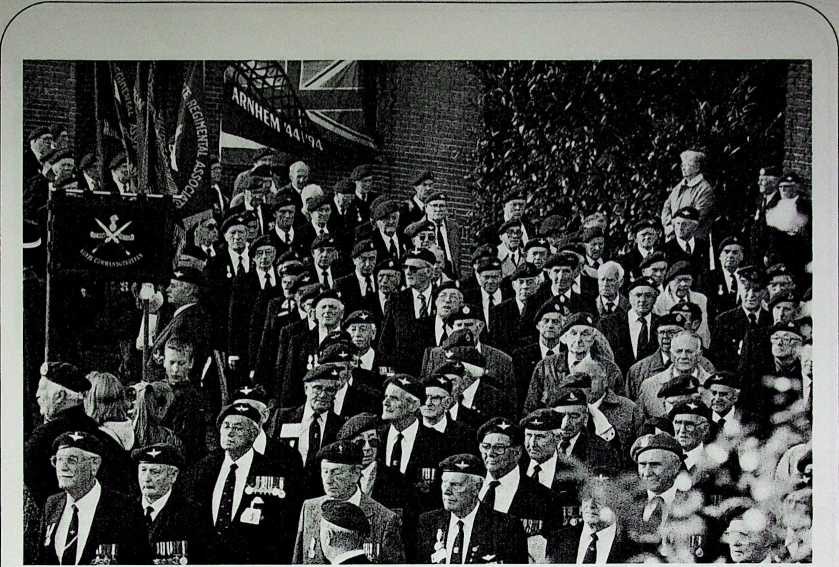
Memorial service at the Eusebius Church in Arnhem on 15 September 1994. From left to right; Dr. J. Terlouw, Queen’s Commissioner for the Province of Gelderland, General Sir John Hackett and Prince Willem Alexander, (photo: Berry de Reus)
Despatchers of the Royal Army Service Corps who were killed 50 years ago. These were the men responsible for dropping the panniers and containers during the re-supply flights.
Many low-flying aircraft fell victim to German anti-aircraft artillery during these flights in the Arnhem area and many lives were lost. Seventy-nine Air Despatchers were among those who died on these re-supply missions.
General Sir John Hackett receives medal of honour from Ede
At a meeting held in Ede town hall on Thursday evening 15 September 1994, the Burgomaster of Ede, Mr. W. Blanken, presented General Sir John Hackett with a medal of honour on behalf of the municipality of Ede. With this presentation the Ede municipal officials wish to honour all Airborne troops who went into hiding in the area fifty years ago.
The badly wounded Brigadier Hackett was hidden for a good four months in the home of the De Nooij family in the Torenstraat, Ede. Early in 1945 he managed to return to the British lines in the south of the Netherlands via the Biesbosch (a watery area of small islands and reed beds to the east of Rotterdam).
Great interest in the photographic exhibition ‘Civilian Images’
This year the annual exhibition held in Oosterbeek town hall concentrated on photographs and films made by the civilian population during the Battle of Arnhem. The exhibition ran from 8 September to 27 October.
This is the first time in 50 years that these ‘civilian images’, as the exhibition is called, have been brought together, and this is thanks to the compilers Geert Maassen and Robert Voskuil.
The search for original pictures from September 1944 brought still more new photographs to light.
Eventually 27 of the photographers could be identified by name, but at the present time ten are still unknown. In total 167 photographs were unearthed, all of which were exhibited whatever their quality.
It was possible to put the original 8 mm film shot by four amateur cameramen onto video, and these were shown during the exhibition.
Many of the people who had wielded the camera in September 1944 were present at the opening of the exhibition on 7 September.
There have been requests from all sides regarding the possibility of putting all the photographs together in a book. As a result both compilers have decided to take a look at what can be done.
Parts of David Lord’s Dakota in the exhibition ‘Final Resting Place in Holland’
An exhibition was held in Oosterbeek public library during September and October to do with the air war over the Netherlands in the period 1939-1945. This exhibition was set up by the Dutch Aircraft Examination Group (DAEG) which has recovered various Allied and German aircraft over the past years.
The exhibits included some remnants of Dakota KG 374 from 271 Squadron. This aircraft, flown by Flight Lieutenant David S.A. Lord, was shot down by German anti-aircraft fire on 19 September 1944 while on a re-supply mission to Arnhem. With the aircraft already on fire and despite the heavy flak, Lord twice circled the supply dropping zone so that the despatches could get the supply panniers away. They managed to drop all the supplies but immediately afterwards a wing broke off and the aircraft crashed near Reijerskamp farm just to the north-west of Wolfheze.
Lord was posthumously awarded the highest British military honour, the Victoria Cross, for his courageous efforts.
The DAEG recovered the remains of the aircraft earlier this year. Parts of other aircraft shot down during the Battle of Arnhem were also on display during the exhibition.
‘The Remains of a Battle’ exhibition gives a view of ‘military archaeology’
Just as they did a few years ago, a number of our association members organised an exceptional exhibition to mark the anniversary in September. It was entitled ‘The Remains of a Battle’ and ran from 12 to 25 September 1994 inclusive at the Westerbouwing. Messrs H.A. Leydecker, M. Hofstede, N. Hulshof, H. van der Velden and M. Clemens exhibited a large part of their personal collections of items that have been found over the years on and under the former battlefield around Arnhem.
Besides pieces of equipment it was the personal belongings of the soldiers which attracted much attention. Everything was well documented and set up in an easy to view manner. Entrance was free but, thanks to the many donations from the visitors, a princely sum could be handed over to the Airborne Forces Security Fund.
Presentation of Middlebrook’s book at the Airborne Museum
Mention was made in the previous Newsletter of Martin Middlebrook’s new book ‘Arnhem, The Airborne Battle’.
The author came over to the Netherlands on the 25th of August 1994 to present both the English and Dutch editions at the Airborne Museum ‘Hartenstein’.
During this informative gathering Middlebrook explained to the assembled press how he had gone about writing the book. He began in 1989 by reading through all the official reports held by the Airborne Forces Museum archives at Aidershot.
He next interviewed, personally or by letter, some 500 veterans. Armed with this knowledge he then travelled to Arnhem in order to study the battlefield in detail and to interview a number of civilians who had been caught up in the fighting.
Finally Middlebrook began writing. Originally the publisher allowed him 120,000 words but this was eventually stretched to 160,000 words, resulting in a book of about 500 pages.
‘Arnhem, The Airborne Battle’ is Middlebrook’s last book; from now on he intends concentrating on guiding interested parties around the battlefields of Europe.
Author of ‘Arnhem Lift’ visits Oosterbeek
By January 1945 the first little book about the Battle of Arnhem was already in the bookshops. It was called ‘Arnhem Lift, Diary of a Glider Pilot’. The first edition appeared anonymously for security reasons. The Dutch version, which was published in 1946 under the title ‘Ik vocht om Arnhem, Dagboek van een zweevliegtuig-piloot’ (I fought at Arnhem, Diary of a glider pilot) did indeed carry the author’s name: Louis E. Hagen. Fifty years after the battle he was back in Oosterbeek.
In September 1944, when he fought in houses on the eastern side of the perimeter, he became acquainted with an Oosterbeek family. Mr. and Mrs. Kremer, their 11 year old son Sander and 12 year old daughter Ans, lived at the time in a large villa, no 8 Stationsweg. During the 50th anniversary Louis Hagen stayed at Ans Kremer’s house in Mariaweg, close to Stationsweg. On a walk past the old house, Louis Hagen, Ans and Sander reminisced about September 1944.
Hagen’s book ‘Arnhem Lift’ has been published far and wide and in many languages over the last 50 years, and recently a revised and expanded edition appeared. It includes the story of Major Winrich Behr, who in September 1944 was involved in the battle as Field-Marshall Model’s Adjutant. Winrich Behr and Louis Hagen met each other 45 years after the Battle of Arnhem during a dinner in Germany, and became friends. Hagen decided to include Behr’s story in his book so as to give the German view. This new edition of ‘Arnhem Lift’ is published by Leo Cooper, London, and costs £ 13.95
‘Arnhem, A Tragedy of Errors’
Last September the book ‘Arnhem, A Tragedy of Errors’ appeared, coinciding with the 50th anniversary of the Battle of Arnhem. The author is Peter Harclerode.
In this book the author provides an objective analysis of operation Market Garden in which, as well as looking to existing publications, he makes extensive use of original sources such as the War Diaries from the Public Records Office in London.
He describes the preparations for this gigantic ground and air operation in a systematic manner, and points out where the most important evaluation faults were made.
One of the interesting aspects investigated by Harclerode is the part played by the decoded German messages, under the code name ‘Ultra’. The messages, which were decoded at Bletchley Park near London, provided the Allied high command with exact details of German troop movements, and therefore the movement and strength of the 9th and 10th SS Panzer Divisions in the Arnhem area as well. The author has consulted all these TJItra’ messages for his book.
In the chapters concerning the progress of the battle, the operations of the Airborne Divisions, 30 Corps and of the German units are looked at in turn. In particular, his analysis of 30 Corps’ operations provides an interesting and nuanced picture of the causes for the delays in this Corps’ advance. ‘Arnhem, A Tragedy of Errors’ is published in Britain by Arms and Armour Press, London. It is illustrated with photographs and maps and costs £ 16.99.
‘Nothing is Impossible’
At the beginning of September last a book bearing this title and written by ex-glider pilot Victor (Dusty) Miller made its appearance. In it the writer describes his experiences during the airborne landings on
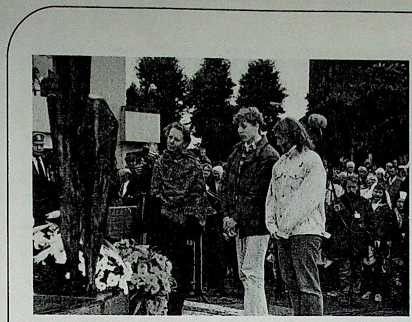
17 September 1994. Three of General Stanislaw Sosabowski’s grandchildren lay flowers at the Polish monument in Driel. General Sosabowski commanded the 1st Polish Independent Parachute Brigade Group in 1944. (photo: Berry de Reus)
Sicily in 1943, at Arnhem in 1944, and during the Rhine crossing in 1945. His story is based on diary notes which he began making at the start of his military service. After his demob in 1946 he expanded on his notes.
Now, fifty years after ‘Arnhem’, he and his son have reworked and published the manuscript. The result is an extremely interesting and readworthy book. One hundred and thirty of the 276 pages are devoted to Miller’s lot during the Battle of Arnhem.
He spent the greater part of the battle in the grounds surrounding the British headquarters at the Hartenstein Hotel, and he describes in great detail what happened to him in those days. Fie manages to recapture very vividly the atmosphere during the patrols, the shelling and the fighting around the Hartenstein. The locations where the various events took place are indicated on a map of the area. Miller was among the lucky ones who managed to escape across the Rhine during the night of 25-26 September 1944, and this episode is also dealt with extensively in the book.
Last 17 September Victor Miller was at the Airborne Museum together with his son to sell signed first editions of the book himself.
‘Nothing is Impossible’ is illustrated with photographs and maps. The book is published in England by Spellmount, Staplehurst, United Kingdom (ISBN 1-873376-30-8) priced £ 18.95. It is also available at the Airborne Museum ‘Hartenstein’ for / 56,-.
‘Without Tradition, 2 Para 1941-1945’
The 2nd Parachute Battalion has without doubt become most well-known as the battalion which, in September 1944 under the command of Lieutenant- Colonel John Frost, defended the Rhine bridge in Arnhem against overwhelming German forces. However, the history of this battalion does not begin and end with ‘Arnhem’, and this history has recently been put together by Robert Peatling in the book ‘Without Tradition, 2 Para 1941-1945’.
The battalion was formed in 1941. Volunteers from all the various regiments of the then British army reported for service with the new airborne units. These units had no military tradition, hence the title of the book ‘Without Tradition’.
The first important operation carried out by this battalion after an intensive training period was the raid on Bruneval in northern France in February 1942. C Company, under Major John Frost, was successful in capturing parts of a German Wurzburg radar installation and returning them to England for examination.
Frost was given command of the entire battalion in October 1942, a command he would hold up to and including the ‘Arnhem’ operation. The battalion took part in operations in North Africa from November 1942 up until July 1943, after which it was sent to Sicily on 13 July 1943, and then to Italy. The 2nd Parachute Battalion returned to England at the beginning of December 1943 to prepare for the invasion of Europe.
On September 17 1944 the battalion, 31 officers and 487 other ranks strong, took off for Arnhem. At the roll-call in Nijmegen after the evacuation on 25 September just 17 men of the 2nd Parachute Battalion answered their name.
The book relates the history of the 2nd Parachute Battalion based on official reports but especially through a multitude of personal accounts from veterans of the battalion.
The book costs £ 16.95 and can be obtained in the UK by ordering direct from the author: Robert Peatling, 36 Park Lane, Wimborne Minster, Dorset BH21 1LD. The book is available in the Netherlands from Mrs. Pelster in Oosterbeek, tel. 085-333479, at/ 50,- including postage and packing.
‘Sprong in de Afgrond’ (Leap into the Abyss)
That is the title of a book written by the Dutch journalist Harry van Wijnen about the failure of Operation Market Garden. Following a study of the available literature, Van Wijnen has produced yet another list of the most important reasons for the failure of the operation.
The book is written in a racy style, but in his analysis of the historical facts the author quite often falls into the trap of making ‘cheap’ generalisations. He regularly makes extremely black/white assessments of people and situations. Field-Marshall Montgomery in particular, but Major-General Urquhart as well, bear the brunt of his criticism.
It would appear from a number of annoying mistakes here and there in the book that the author himself is not exactly infallible. Consequently brigades, landing zones and landing data are mixed up with one another in an irritating manner. Although the book provides a reasonable overall picture you will not find in it ’this tragedy shown in a surprising new light’ as the text on the back cover would have us believe.
‘Sprong in de Afgrond’ is only available in the Dutch language and is published by Uitgeverij Balans. It contains 161 pages, is illustrated with photographs, and costs f 27,50.
An overall look at 50 years of commemoration
The Open Air Museum in Arnhem organised an exceptional exhibition which ran from the beginning of September until mid-October last. The exhibition was called Van oorlogsherinnering naar monument, 50 jaar herdenken van de Slag om Arnhem’ (From memory of war to monument, 50 years of commemoration of the Battle of Arnhem).
The exhibition was opened on 1 September by Dr. L. de Jong, former director of the State Institute for War Documentation and historian of the Kingdom of the Netherlands during the Second World War.
During the exhibition the book ‘Don’t forget us; we shall not forget you’, written by J.O. van der Heijden, was available for purchase. This book, which is in Dutch and English, gives a survey and analysis of 50 years of commemorations.
The book is illustrated with photographs and is published by the Open Air Museum.
New catalogue of books about the Battle of Arnhem
In 1975 Dr. P.G. Aalbers compiled a bibliography of books about the Battle of Arnhem. A supplement to this bibliography appeared in 1978.
Arnhem Library possesses a large collection of literature to do with operation Market Garden, at the moment some 1,500 titles. Within the framework of the fiftieth anniversary of this operation, the library has published a catalogue of this collection. One difference between the aforementioned Aalbers bibliography and this Arnhem Library publication is that, whereas Aalbers lists literature which is not connected to any particular collection, the new catalogue only contains titles which are in the possession of Arnhem library.
The catalogue, compiled by M.H. Alofs, is available from Arnhem Library, Koningstraat 26, Arnhem, price f 10,-.
Book of photographs of the Battle of Arnhem commemoration
‘Vijftig jaar na de Slag om Arnhem’ (Fifty years after the Battle of Arnhem) is the title of a book of photographs which gives a survey of the commemorations in September 1994.
The book, published by the Arnhemse Courant/the Gelders Dagblad (two local newspapers), contains many colour photographs with captions and an introduction by the paper’s chief editor, G. Dielessen. It contains 32 pages and costs f 15,-.
The proceeds from the sale of this book will be used entirely for the setting up of a monument to the evacuation of Arnhem in 1944 (see elsewhere in this Newsletter).
The book ‘Vijftig jaar na de Slag om Arnhem’ can be purchased from all offices of the Arnhemse Courant, the Gelders Dagblad, the Apeldoornse Courant, the Deventer Dagblad and the Overijssels Dagblad.
Video documentary ‘We’ll See You In September’
In the previous Newsletter mention was made of the preparations for the production of a video documentary about the 50th commemoration of the Battle of Arnhem. This documentary, produced by Bal Bedrijfsvideo of Oosterbeek, has recently been completed and is now on sale.
‘We’U See You In September’ gives an impression of the various commemorative meetings and get- togethers during the 50th anniversary. There are reports on events such as the Silent Procession and wreathlaying in Arnhem, the dropping of British parachutists at Ginkel Heath, the wreathlaying at the monuments in Oosterbeek and Driel, the parade of honour in Arnhem and the highpoint, the service of remembrance at the Airborne Cemetery in Oosterbeek.
In addition the film contains many authentic pictures made by British and German film makers and amateurs in September 1944, film of the liberation of Arnhem in 1945 and old cinema newsreels of the first commemorative gatherings just after the war. All is interspersed with interviews with old combatants and with civilians who were involved in the fighting at close range.
There are Dutch and English versions of the film and the running time is 82 minutes. Joop Bal presented the first copies of the video to the burgomasters of Arnhem, Renkum, Ede and Heteren – Mr. P. Scholten, drs. J.W.A.M. Verlinden, Mr. W. Blanken and Mrs. A.E. Verstand respectively – during a festive meeting at the Airborne Museum on 17 October.
Information about this film can be obtained from Bal Bedrijfsvideo, Rozensteeg 1,6862 DH Oosterbeek.
Video for the schools
Thanks to the sponsorship of R.Z.R. Zorgverzekeraar from Doorwerth (an insurance company), the Society of Friends of the Airborne Museum was able to present all the schools which took part in the laying of flowers at the Airborne Cemetery with a copy of the video ‘We’U See You In September’.
Each year the Society of Friends provides a fitting gift for the participating pupUs. This year they each received a copy of the Society’s publication ‘De Tommies Komen’ (The Tommies are Coming). Thanks to the donation of this video to the schools, young people will be able to acquaint themselves now and in the future with the things that happened in this region in 1944, and how these events have led to the annual commemoration.
Airborne Museum receives documents from the ‘Ryan Archives’
All the documents, diaries, interviews etc that Cornelius Ryan compiled during the years he was writing Iris books ‘The Longest Day’, The Last Battle’ and ‘A Bridge Too Far’ were handed over by his widow to Ohio University in America on his death in 1974. There they can be consulted for historical investigations.
A large number of copies of the ‘Battle of Arnhem’ reports and interviews have now been placed at the disposal of the Airborne Museum ‘Hartenstein’ in Oosterbeek. During an informal meeting held on 8 September, Doug McCabe and Adrie H. Nab, archivist and Vice President for University Relations respectively at Ohio University, presented a small selection of the Ryan Archives for display in the museum. The rest of the documents will follow shortly.
Regimental flags fly in front of the Airborne Museum
During the recent days of commemoration in September 1994, the flags of many of the units which took part in the Battle of Arnhem were flown from the flagpoles in front of the Airborne Museum. Thanks to the initiative and drive of our member Don Jacobs, an employee of the museum, 16 flags from various museums and barracks in the UK were brought over to the Netherlands. Jaap and Bart van Genderen, both Friends, ensured that the flags were raised and lowered each morning and evening, and each evening their mother took care of the hanging out and drying of the flags. Piet Spronk and Cees Wichart, both employed by Renkum council, provided the necessary assistance.
Commemorative envelope
This year sees the 17th issue of an annual commemorative envelope by the Airborne Museum Foundation.
A special drawing was made for this envelope by the Arnhem artist Ben Speijdel depicting various aspects of the Battle of Arnhem. The 90 cent stamp, which was issued to mark the 50th anniversary of Operation Market Garden, was chosen for this envelope and it is specially franked with the date ’17 September 1994′. The envelopes are numbered from 1 to 1,000 and are available from the Airborne Museum at £ 5,- each.
The issue of this 17th commemorative envelope ends the series.
Airborne commemorative art poster
Within the framework of the September commemoration all veterans received a special Airborne poster presented on behalf of the Renkum municipal management. The art poster was produced by the Oosterbeek photographer Henk Gerri tsen.
Other interested parties can also obtain a copy of this handsome poster. It costs just f 5,- and is available from the Oosterbeek town hall Information Department, the Airborne Museum ‘Hartenstein’ and the VW tourist offices in Oosterbeek and Arnhem.
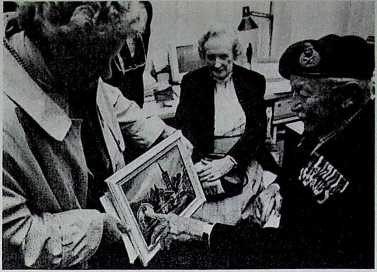
During a visit to the Airborne Museum General Sir John Hackett is presented with a small painting of the house in Ede where he was in hiding in the autumn of 1944. Mrs. Urquhart looks on with interest.
(photo: Bern/ de Reus)
Airborne Commemoration Foundation booklet still available
1. At the end of August a jubilee booklet was published by the Airborne Commemoration Foundation to mark the 50th commemoration of the Battle of Arnhem entitled ‘The Battle of Arnhem 1944-1994’.
Besides the official programme the booklet contains three articles. The first gives an overall picture of the battle in September 1944, the second deals with the origin and development of the Airborne commemoration and the third is a reflection regarding the future form of the commemoration. The booklet, which is available in three versions, namely Dutch, English and Polish, comprises 52 pages and is illustrated with photographs, including some so far unpublished.
Last September veterans of the Battle of Arnhem received a copy as a gift. For those interested there are still a number of copies available from our society or from the Oosterbeek town hall Information Department.
2. A book, linked to the extensive schools programme, was published in April 1994 entitled ‘Een Brug naar de Toekomst’ (A Bridge to the Future) and written by Jan Durk Tuinier. It is a text book intended for the young and is aimed at ‘building a bridge from the past to the future’. It contains various stories, poems, and the words of the commemoration anthem, comprises 125 pages and is illustrated with 30 photographs.
3. A colour poster (screen print) has also been produced for the school programme giving a symbolic impression of the new style of commemoration.
Market Garden supplement from ‘de Gelderlander’
Free copies of the special edition of ‘de Gelderlander’ newspaper about Operation Market Garden can still be obtained from the Oosterbeek town hall Information Department. Stock of the English version, ‘The never ending story7, is limited but the Dutch edition ‘Het verhaal van toen en nu’ is in plentiful supply.
‘Arnhem, a musical tribute’
A CD and a cassette tape of music and song by Max Bygraves, the children from the Pieter Breughel School, Arnhem, the Les Reed Orchestra and the band of the Parachute Regiment arrived on the market in September under the above title. The CD costs £ 15,- and the cassette £ 10,-. The proceeds from the sale of these items will be presented to the ‘Airborne Forces Appeal’ in Aidershot.
Among the places where the CD and tape can be bought is the Airborne Museum ‘Hartenstein’, the Oosterbeek town hall Information Department and Meijer & Siegers bookshop in Oosterbeek.
Souvenir sales reach record levels
The enormous public interest in the 50th commemoration of the Battle of Arnhem also resulted in a tremendous increase in souvenir sales. Not only were the sales extremely good at the Airborne Museum shop and at the sales stand of the V&D (a departmental chain store) exhibition in Arnhem, but the stands set up at the various events in the area also made overtime.
As far as our association is concerned a special mention has to be made of our secretary Mieke de Langen. Together with her trusty colleague Riet Sandbrink she was there with her sales stand at all sorts of gatherings, whatever the weather. Over that period they eventually accounted for some 25,000 guilders worth of souvenir sales!
Generous gift from 7 KOSB
Last year Company Sergeant-Major Jimmy Swanston organised a collection among the veterans of the 7th (Galloway) Battalion The King’s Own Scottish Borderers for the benefit of the Airborne Museum ‘Hartenstein’ renovation. Many answered his call, and on Friday afternoon 16 September 1994 the delegation handed over a cheque for £ 1,200 (!) to the Foundation management.
Following a ringing speech from CSM Swanston Mr. Groeneweg thanked all concerned on behalf of the management. He let it be known that he would have to revise his ideas regarding Scottish thriftiness since very few groups have ever collected so much money.
Memorial columns at prominent points from the Battle of Arnhem
For many years now in Oosterbeek memorial columns have marked prominent places from the Battle of Arnhem.
In September and October last and to mark the 50th commemoration, the Cultuur, Educatie en Sport (Culture, Education and Sport) service of the Arnhem municipality, together with the VW (Tourist information service), placed five such memorial columns at locations which played an important part during the battle. Thanks to the cooperation of the Ruimte (Space) sector of the Renkum municipality, which holds the copyright for the design, the granite columns are exact replicas of those in Oosterbeek.
They are located at the Boterdijk, in front of the St Elisabeth’s hospital, at the Town hall, at the ramp up to the John Frost Bridge and at the spot where the Van Limburg Stirum school used to stand.
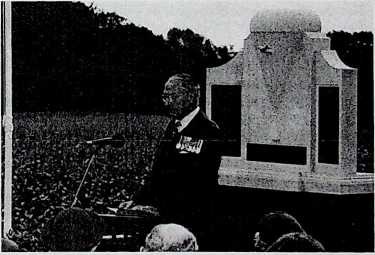
Colonel Rupert Wallis, vice president of the organising committee, makes a speech during the unveiling of the memorial to the Air Despatchers who lost their lives during the battle (18 September 1994).
(photo: Bern/ de Reus)
General Sir John Hackett presents unusual souvenir
During the period that Sir John Hackett was in hiding with the De Nooij family in Ede he carried a false identity card bearing the name ‘Johan van Dalen’. In those days he wore a badge which bore the letters ‘S.H.’ (Slecht Horend = ‘partially deaf or ‘hard of hearing’). If caught by the Germans he could then act as if he didn’t understand and was therefore not obliged to answer.
Sir John Hackett handed this unusual badge over to the Airborne Museum THartenstein’ during the recent anniversary.
Medal sets
Recently the Airborne Museum have been given various personal medal sets. We shall be giving a summary of these medal sets in this and the next Newsletter.
1. Dr. M.C.J. Pilaar, former surgeon in Apeldoom: King’s Medal for Courage in the Cause of Freedom. Mr. Pilaar died on 8 September 1965.
2. Flight Engineer Malcolm Mitchell, RAF: 1939/45 Star, France and Germany Star, War Medal with Mentioned in Despatches, General Service Medal with Palestine clasp 1945-1948.
3. Lt. P.J. Brazier, Glider Pilot Regiment: 1939/45 Star, Italy Star, France and Germany Star, Defence Medal, War Medal with Mentioned in Despatches.
4. L/Cpl T. McEwan, ‘D’ Coy 10th Parachute Battalion: 1939/45 Star, Africa Star with 8th Army clasp, Italy Star, France and Germany Star, Defence Medal, War Medal.
Veteran presents oak tree to Renkum municipality
For the first time in 50 years, 74 year old veteran Mr. Les Seviour from Chippenham, Wiltshire in England visited the place where his comrades fought in September 1944. He brought with him an oak sapling as a gift to the municipality of Renkum.
After consultation it was decided to plant the sapling in the Hartenstein Park, close to the deer park. The planting took place on 21 September 1994.
Pegasus Walk attracts record number of participants
The 11th Pegasus Walk which was held this year on Saturday 22 October attracted almost 2,500 participants. Last year the figure was almost 1,750. The journey, which started from the Floor cafe in Lunteren, keeps alive the memory of the Pegasus I and II operations.
During operation Pegasus I on 22 October 1944 almost 150 military personnel, who had gone into hiding in the Veluwe following the Battle of Arnhem, were taken across the Rhine to the liberated part of the Netherlands aided by the underground movement.
Within a month operation Pegasus II took place, but this failed. Of the 120 men who attempted to reach the Rhine in this operation only eight eventually managed to cross to the far bank.
Next year the Pegasus Walk will be held on Saturday 28 October.
Monument commemorating the evacuation of Arnhem
It is well known that directly after the battle was lost, Arnhem and a number of surrounding villages were evacuated by order of the Germans. More than 95,000 people were driven out of Arnhem alone. Only after April 1945 were they allowed to return to their totally plundered town.
An exhibition about the evacuation was held in the Visitors’ Centre at the Watermolen (the Water mill) in Sonsbeek Park from 17 August up until 23 October. This exhibition attracted an enormous number of visitors, and very quickly the idea was mooted of setting up a monument to commemorate what was, for Arnhem and surroundings, a terribly traumatic period.
It is intended that the new ‘evacuation’ monument in honour of the evacuees will be unveiled on or about the 14th of April 1995, exactly fifty years after the liberation of Arnhem. It will probably stand on the Apeldoornseweg at the entrance to Sonsbeek Park.
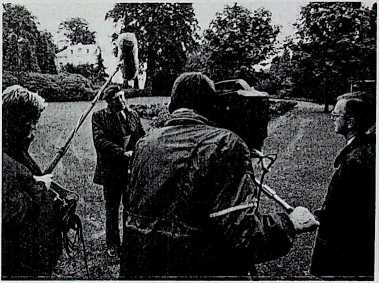
Colonel Paddy de Burgh is interviewed for the video documentary ‘We’ll See You In September’ at the place in the Hartenstein Park where artillery headquarters was located in September 1944.
(photo: Berry de Reus)
House once again bears the historic name ‘Monty’
During the fighting in Oosterbeek in September 1944 the Kardol family sheltered in the cellar of their house at no. 17 Paasberg. The British soldiers who fought in and around the house told them that Field Marshall Montgomery, whom they called ‘Monty’, would soon be here to relieve the Airborne soldiers at Arnhem.
Although the operation eventually failed, the name ‘Monty’ made such an impression on Mr. Kardol Sr. that, after the liberation, he decided to call his house ‘Monty’, and he made and fixed a nameboard to the house bearing that name.
However, when the house was extended in the seventies the board disappeared from the front wall. Now, fifty years after the Battle of Arnhem, Mr. Han Kardol, son of the original owner, has royally restored the original nameboard and re-fixed the name ‘Monty’ to the wall of the house on the Paasberg.
Download nieuwsbrief
